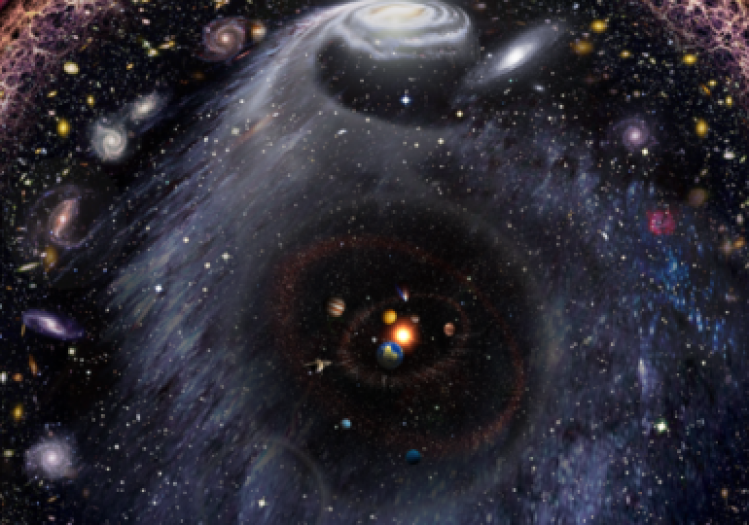
An increasing number of cosmologists now believe in the existence of a multiverse. Multiverse theory holds that, in addition to our Big-Bang universe and its several hundred billion galaxies, there exist countless other universes, undetectable from within our own.
It’s a thrilling prospect; but does a multiverse really exist? Though the theory is based on no actual evidence, Max Tegmark takes it to be a legitimate scientific idea. Indeed, this highly respected MIT particle physicist not only believes that a multiverse exists, but that it can tell us why the Big-Bang universe expands at the rate it does, why the force of gravity is what it is, and ultimately why life arose in our own universe. As if that were not enough, it turns out that multiverse theory—if properly elaborated—also answers the big philosophical questions thoughtful people have always asked: Is matter all there is? Are we free or determined? Do accidents really happen? Were we meant to be here? Was the universe created and does it have a purpose? What is the good life? Why get up in the morning?
To answer these questions and more, all we have to do is leap with Tegmark into the mathematical space opened up by a single grand idea, the multiverse. If we take that leap, we will find out that the physical universe is just the outward expression of an underlying, ultimately mathematical world. We will learn that life exists not through divine plan, but because the multiplicity of universes all but guarantees—statistically—that some will be well suited to life. How then, in light of such revelations, should you conduct your life day to day? In Our Mathematical Universe, Tegmark advises you to adopt a “scientific lifestyle.” Rejoice that you live in a multiverse, where other versions of you exist in parallel worlds.
How can a theory for which there is no evidence—astrobiology is another—qualify as scientific? Multiverse theory qualifies, Tegmark argues, because it is associated with ideas that are testable. One of these is Alan Guth’s widely accepted theory of cosmic inflation. Guth theorizes that our Big-Bang universe underwent an exceptionally rapid expansion during its first instant of existence. Though this expansion rate, a product of what cosmologists now call “dark energy,” quickly decreased, the initial epoch of inflation—less than a trillionth of a second—accounts for some large-scale features of our observable cosmos. One of these is the physical homogeneity the universe exhibits at distances too far apart from one another to be explained by its present expansion rate. Another prediction, not yet confirmed, is that a multiverse exists.
During the inflationary period, dark energy theoretically could have had many different values, only one of which is the expansion rate essential for our Big-Bang universe. Hidden from us there may accordingly exist zillions of parallel universes, most of them lifeless and mindless, branching off prolifically and even eternally from a now-invisible “mother universe.” Even though all these other universes lie beyond the horizon of detection in our cosmos, the mere fact that Guth’s theory of cosmic inflation is open to empirical confirmation means for Tegmark that other predictions associated with inflation qualify as scientific, no matter how opaque to observation they may be at present. Anyway, mathematical reasoning and desktop computers can fill in whatever experimental gaps remain.
Our Mathematical Universe provides a readable and entertaining survey of the physics associated with speculation about the multiverse. If the author’s criteria of scientific integrity seem loose, and his reduction of all reality to mathematical abstractions ethereal, one can nonetheless learn a lot about standard contemporary physics from this book—even when it sails beyond the clouds. Tegmark’s diagrams and compact summaries are done with admirable originality, and one can well imagine that he is a resourceful teacher.
But is this book really about science? These days, popular books purporting to discuss science are as likely to be presentations of their authors’ worldviews as they are summaries of scientific research. If one can separate the philosophy from the science, such works can be worthwhile for nonscientists, and in this respect Tegmark does not disappoint. Our Mathematical Universe is certainly scientifically educational. Yet a more enthusiastic fusion of physics with metaphysics would be hard to find, beginning with the book’s tendentious subtitle, “My Quest for the Ultimate Nature of Reality.”
Tegmark shows no awareness that his underlying philosophical perspective is a strange and even contradictory admixture of elements; his book blends ancient, medieval, and modern philosophical ideas into unpredictable hybrids on almost every page. Furthermore, although Tegmark has no use for a divine creator and seems most at home among scientific naturalists, there is something eerily supernaturalistic about his enshrinement of mathematical abstractions as ultimately and eternally real. The real world, he insists, is “out there,” completely external to the knower, yet the reality that exists “out there” is purely numerical. While not ignoring altogether the importance of field work, Tegmark severs the mathematical from the experimental aspect of physics and launches his readers into a realm of pure numbers that he views as concrete and fundamental. As a result, he feels no need to draw a clear distinction between science and metaphysics.
He is not alone. Many scientists who make a name for themselves in one or another scientific specialty find it hard these days to resist the invitation to comment more generally on the philosophical, ethical, and theological implications of their disciplines’ discoveries. They are doing so increasingly without observing the long-held distinction between science and philosophy. You may gather useful scientific information from such books, but chances are you will be treated to extravagant metaphysical excursions you didn’t pay for. You can learn much about evolution from reading Richard Dawkins, for example—but as a bonus you will also learn that matter is all there is, that the universe is pointless, and that Darwin has delivered you from the compulsion to pray and worship.
Nowhere is the metaphysical adornment of scientific writing more extravagant than in works by celebrated physicists and cosmologists. Ever since Stephen Hawking suggested, in A Brief History of Time, that astrophysics makes a divine creator unnecessary, popular works on particle physics and cosmology have grown comfortable mingling science with talk about God—negative talk—and in the process turning their books into platforms for atheistic evangelizing. Cal Tech physicist Sean Carroll speaks for many when he declares that “if and when cosmologists develop a successful scientific understanding of the origin of the universe, we will be left with a picture in which there is no place for God to act...” Similarly, in A Universe from Nothing, physicist Lawrence Krauss interweaves important scientific information with his New Atheist message, while signing up Richard Dawkins to predict, in an afterword, that “If On the Origin of Species was biology’s deadliest blow to supernaturalism, we may come to see [Krauss’s book] as the equivalent from cosmology.”
To be sure, this twisting of scientific writing into atheistic manifesto partly represents a reaction to creationist and intelligent-design tracts that collapse scientific ideas into religious apologetics. Still, there was a time when scientific skeptics would have been reluctant to use popular science books to persuade scientifically uninformed readers to give up their religious illusions. Albert Einstein, for instance, was no less atheistic than Dawkins on the question of a personal God, but in his popular writings he never cheapened relativity theory by making it a weapon to beat down the uninformed religious masses.
IN THE ACCIDENTAL UNIVERSE, Alan Lightman, another physicist, helps account for the confident new conflation of physics with metaphysics. “Theoretical physics,” he asserts, “is the deepest and purest branch of science. It is the outpost of science closest to philosophy, and religion.” Lightman is also a novelist, author of the international best seller Einstein’s Dreams, and a teacher of writing who holds a dual appointment in science and the humanities at MIT. The Accidental Universe is a compact and readable compilation of thoughtful essays on cosmic size, time, randomness, lawfulness, and hidden mathematical properties. Although the author describes himself as an atheist and shows little familiarity with theology, his comments on religion are closer in spirit to those of Einstein than to those of Krauss and Dawkins.
Though he doesn’t describe his relationship with Tegmark at MIT, Lightman shares his colleague’s interest in the possibility of a multiverse. He worries, though, that evidence of its actual existence could prove fatal to science as we know it. A multiverse would mean that our own universe just happens to have the physical properties essential for life, and that there would be no uniform laws underlying the totality of worlds. It would signify that ours is a completely “accidental universe” suspended over a lawless abyss. The remorseless regularity of nature that modern science has always taken for granted would dissolve in the chaos of unconnected cosmic experiments. Lightman, while not displeased to think that a multiverse would dismiss the need for a purposive deity to account for our own life-friendly universe, is concerned that a natural world without uniform laws would take the predictive starch out of science.
What’s really going on in all this talk about a multiverse? Is the theory a reasonable scientific prediction that might someday be confirmed experimentally, as in the case of black holes? Is it the last, desperate gasp of scientific naturalism as it seeks an alternative to the notion of a divinely created universe designed for life and for us? Or in fact does its unrestrained pursuit of otherworldly horizons express a deeply spiritual need for an infinity that far outstretches what astronomer Harlow Shapley once called the “anthropomorphic one-planet deity” of our familiar faith traditions?
And, finally, is the prospect of a multiverse a real threat to science as we know it? Guth and Lightman, along with the British astronomer Martin Rees, worry that if our improbable life-bearing universe turns out to be the only one around, the idea of divine design might still make sense. So they pin their hopes for atheistic naturalism on particle accelerators and computations that will prove that the universe (or multiverse) sprang “from nothing,” as Lawrence Krauss puts it, rather than from a creator.
I believe that the anxiety associated with the possibility of a multiverse stems from an inordinately shrunken sense of both divine creativity and human intelligence. Atheistic multiversalists such as Tegmark typically assume—unnecessarily—that a divine creator could be neither good enough to delight in the spontaneity and diversity of nature, nor resourceful enough to summon forth an infinity of worlds. And why are Lightman and others so worried that the existence of a multiverse would signal the end of confidence in science and nature’s intelligibility? The idea of a multiverse, after all, is itself a product of our human quest to make sense of things. And even if it turns out to be a bad idea, only a justifiable confidence in our intelligence and reason would permit us to deem it so.


